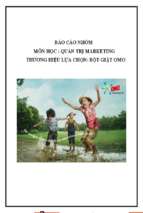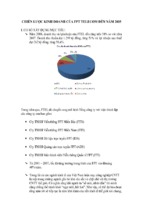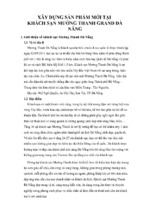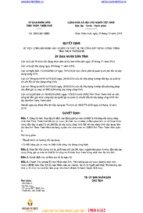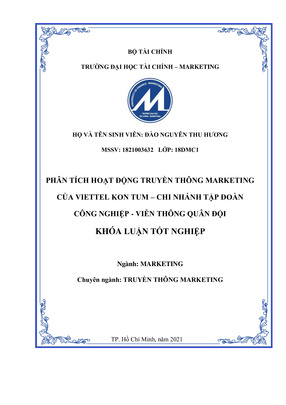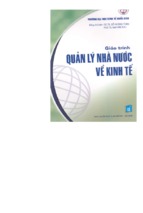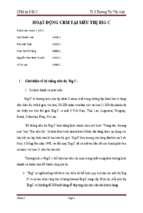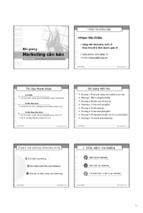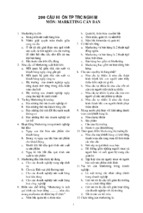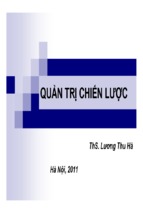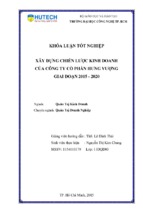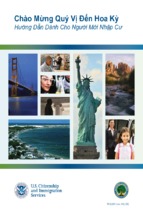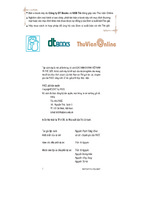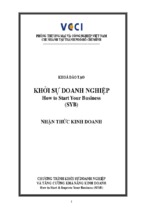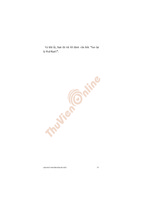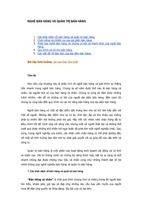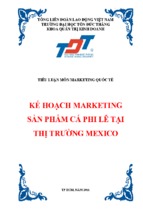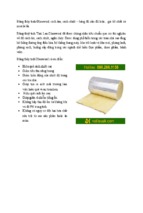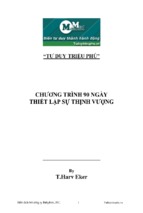Asia Personal Care & Cosmetics Market Guide
2016
This publication is a joint effort of two business units within the International Trade
Administration: the U.S. Commercial Service and Industry & Analysis (I&A). Together these
staff, based in both the U.S. and in over 80 overseas posts, represent experts in industry, trade,
economic analysis and small business assistance. They work together to devise and implement
international trade, investment, and export promotion strategies that strengthen the global
competitiveness of U.S. industries.
These initiatives unlock export and investment
opportunities for U.S. businesses by combining in-depth quantitative and qualitative analysis
with ITA’s industry relationships.
For more information visit:
www.export.gov
www.trade.gov/industry
The mission of the International Trade Administration is to create prosperity by strengthening
the competitiveness of U.S. industry, promoting trade and investment, and ensuring fair trade
and compliance with trade laws and agreements.
Tracy Gerstle, International Trade Specialist in the Office of Materials Industries, served as the
lead editor of this report. Special thanks to Swee-keng Cheong and Tony Michalski, for their
leadership in prior versions of the Asia Cosmetics Market Guide, as well as in reviewing this
report.
Considerable credit is due to ITA’s Global Healthcare Team, who authored the country case
studies, providing considerable market research and field based insights to this report,
including: Swee-keng Cheong, Janet Coulthart, John Kanawati, Angela Han, Janet Li, Pepsi
Maryarini, Chris Ono, Manjushree Pookan, Dey Robles, Ylen Rumeral, Smita Sherigar, Shen
Yan, Tracy Yeoh, Luanne Theseira, and Heesook Baik.
Comments on this report should be sent to Tracy Gerstle:
[email protected]. Contacts
for each of the profiled countries are provided in the country profiles.
Partnering with the International Trade Administration
With its network of offices across the United States and in more than 80 countries, the
International Trade Administration of the U.S. Department of Commerce utilizes its
global presence and international marketing expertise to help U.S. companies sell their
products and services worldwide. U.S. companies can work directly with an
International Trade Specialist in their local area to receive export assistance in the
following areas:
- Developing an international sales strategy for your company
- Determining sales opportunities and target countries in which to sell your product or service
- Identifying international distributors, importers, and other partners to work with around the
world
- Complying with documentary, labeling, and ingredient requirements as well as product
registration
- Counseling and guidance on the overall export process along with input and
resources from other federal government partners and organizations
Locate the U.S. Commercial Service trade specialist in the U.S.
nearest you by visiting http://www.export.gov/eac
Comments and Suggestions: We welcome your comments and suggestions regarding
this market research. You can e-mail us your comments/suggestions to:
[email protected]
Disclaimer: The International Trade Administration provides this report as a
resource to U.S. exporters. Every effort has been made to ensure that the
information presented is complete and accurate as of the date of publication;
however, the U.S. Government assumes no responsibility or liability for any errors or
omissions. Readers are advised to independently verify any information contained in
this intelligence brief prior to relying on it. The information provided in this report
does not constitute legal advice. Readers are further advised to conduct their own
due diligence and seek the advice of legal counsel before entering into business
ventures or other commercial arrangements in this market.
International Copyright, U.S. Department of Commerce, 2016. All rights reserved
outside of the United States.
Table of Contents
Executive Summary .................................................................................................................................................... 5
Country Guide: Australia .......................................................................................................................................... 10
Country Guide: China ............................................................................................................................................... 20
Country Guide: Hong Kong ...................................................................................................................................... 32
Country Guide: India ................................................................................................................................................ 44
Country Guide: Indonesia ........................................................................................................................................ 54
Country Guide: Japan ............................................................................................................................................... 63
Country Guide: Malaysia .......................................................................................................................................... 73
Country Guide: New Zealand ................................................................................................................................... 82
Country Guide: Philippines ...................................................................................................................................... 87
Country Guide: Singapore ........................................................................................................................................ 93
Country Guide: South Korea .................................................................................................................................. 102
I.
Market Readiness Checklist ....................................................................................................................... 111
II.
Country Data .............................................................................................................................................. 111
Executive Summary
There Has Never Been a Better Time to Enter Asia’s Cosmetics Market Place
The countries in the Asia report represent some of the largest and high potential markets for export-led
growth for the U.S. Personal Care and Cosmetics industries. Comprising over 20% of U.S. global exports in
the sector, the Asia countries offer the industry over 3 billion potential consumers in the fastest growing
global markets. This base includes consumers in well-established markets for U.S. products such as Japan,
Australia and South Korea, which together accounted for more than $1 billion in U.S. personal care and
cosmetics exports in 2015—to China, which at an estimated $500 to $600 million in U.S. exports that same
year, is predicted to become the largest global market for cosmetics in the next two to three years. 1
In addition, the countries included in the Asia Personal Care and Cosmetics Guide provide access to some of
the highest potential future markets—including the growing middle class in countries spanning from
Indonesia to Vietnam to Malaysia. These consumers aspire to the quality and sophistication for which U.S.
products are known. Currently these markets source most of their basic personal care products such as
shampoos, soaps and other grooming products from mass market U.S. companies including Procter and
Gamble, Johnson and Johnson and Colgate-Palmolive. Increasingly these consumers are moving beyond the
basics to premium skin and hair care as well as color cosmetics opening the door to a wide variety of U.S.based cosmetics exporters.
Table 1 summarizes three years of U.S. exports to these markets, which have grown across the region by an
average annual rate of 6% over the last five years, even during the global downturn of 2011-2012. Stunningly,
in some countries U.S. exports have grown by as much as 62% over the past three years in high potential
markets such as Indonesia, Vietnam and China and this growth is predicted to continue.
Table 1: Summary of US Exports to the Asia Countries ($USD)
2013
2014
2015
5 Yr CAGR
3 Year Growth
Hong Kong
$528,831,000
$521,959,000
$516,669,000
NA
-2%
Japan
$519,891,675
$491,176,604
-1%
-14%
$424,921,167
$489,771,533
$487,148,249
4%
15%
China
$324,183,216
$336,578,269
$392,606,007
15%
21%
Singapore
$313,969,980
$324,815,120
$340,553,935
6%
8%
Thailand
$75,207,022
$86,657,330
$80,417,978
2%
7%
Malaysia
$63,298,633
$71,122,679
$78,917,998
9%
25%
Philippines
$52,876,097
$60,813,319
$56,935,354
8%
8%
Vietnam
1
$568,489,269
South Korea
$40,108,841
$52,840,162
$53,481,224
11%
33%
The estimate of U.S. exports to China is based upon exports to the mainland and an estimated 40% of U.S. exports to Hong
Kong, given that these products are then re-exported to China via visitors and other channels.
India
$49,084,035
Australia
$19,414,099
Total
$2,051,018,946
Source: Trade Policy Information System (TPIS)
$53,771,347
0%
10%
$29,362,407
$31,398,239
9%
62%
$2,157,192,939
$2,197,349,243
6%
7%
$55,636,277
Across many of these markets, as illustrated in Table 2, per capita levels of cosmetics spend is still very low,
when benchmarked against peer countries such as the U.S. or Japan. China for example, only spends $24 per
person annual on personal care and cosmetics products, whereas South Korea and Japan spend $171 and $174
annually. 2
Table 2: Per Capita Cosmetics Spend in TPP Countries 2014
Per Capita Cosmetics Spend, 2014
China
U.S.
France
South Korea
Japan
Australia
Malaysia
New Zealand
Singapore
Vietnam
Source: US Department of Commerce Estimates
$24
$139
$139
$171
$174
$30.47
$7 (2013)
$84.92
$299 / $90
$5.28 (2013)
K-Beauty Leads in Product Trends, While U.S. Brands Lead in Trust and Quality
Lead by the global K-Beauty craze, these markets also represent some of the most discerning, sophisticated
cosmetics consumers. Vis-s-vis their U.S. counterparts, urban women in many of these countries use five or
more products daily. In line with regional cultural values, the most popular products are multifunctional skin
care products, protecting skin from harsh sun and other environmental conditions, while promoting skin tone
that is even and light. As a result, skin care products represent up to 40% of sales in some markets. However,
as Korean and Indian TV and pop-stars dominate popular culture, many young and professional women are
increasingly experimenting with color cosmetics. This is reflected in U.S. export statistics in which color
cosmetics, including lip, eye and nail polish are among some of the fastest growing categories. The region’s
men are also increasing consumers of both personal care and grooming products. Similar to women, they value
even, clear skin tone and are also willing to experiment with cosmetics. Specialty hair care products, including
2
Singapore’s per capita cosmetics spend is not reflective of domestic demand, as 70% of all cosmetics are re-exported. Therefore, actual
per capita spend is likely closer to $90 per person, per annum. (2) Data provided for Malaysia and Vietnam is based on 2013 size of the
cosmetics market.
styling products, conditioners and colorants are also growing quickly. These products need to help Asia
consumers deal with regional conditions, such as the ability for easy washing due to hard water and stylants
that can deal with high humidity, while giving body and UV protection to thicker hair.
To be successful in many Asian markets, companies also need to be sensitive to local trends and competition.
For example, Indonesia, representing the largest Muslim population in the world, passed a regulation in 2015
that by 2020 all cosmetics products will have to be labeled as Halal. Whereas in China and India, there is a
strong interest in local ingredients and herbal traditions and the properties that these essential oils and other
products can bring to personal care products and cosmetics. Asian consumers are also somewhat discerning in
terms of packaging. K-Beauty has fueled this trend, with its whimsical and innovative packaging including the
air cushion, peel off makeup and lip balms in the shapes of flowers or panda bears.
Smart phone penetration and use for e-commerce is also higher in some Asian countries than even in the U.S.,
with for example the majority of Chinese consumers having purchased products via e- commerce using their
smart phones. Asian consumers also rely on e-commerce to access products, not available in their local
market—particularly if they live in second or third tier cities rather than their national capitols. E-Commerce as
a result, offers a highly viable entry route for U.S. companies seeking to enter Asian markets. However,
companies should be aware that Asia’s discerning consumers also expect to be engaged via sophisticated digital
marketing and social media campaigns.
Direct Selling is still very popular in some markets, such as the Philippines, where Avon is the largest seller of
color cosmetics and Singapore, where direct selling is used as an entry strategy. There is also growing interest
in accessing products through specialty salons and doctor-led channels. Private-label brands are also
increasingly popular, as the region’s retail, hospitality chains and other channels seek to brand these products.
While being mindful of the need to not overly characterize trends across these 11 highly differentiated
markets, there are a number of trends of note.
Baby and Child Care Products (Top Export Opportunity)
With Asia’s rapidly growing population, baby and child specific products are among the fastest growing product
category. While this category is still relatively small—often less than 5% of each country’s total domestic
market—it is expected to continue to grow, given Asian helicopter parents, who pamper and dote on their
children. It also is a highly competitive category for imported products, given consumer sensitivities to the
safety of these products, given high levels of adulteration of personal care products. There are still relatively
few players in this market outside of Johnson and Johnson, offering a significant niche opportunity for U.S.
companies new to the market. Moreover, U.S. branded products also benefit from their strong reputation and
track record of safety. However, U.S. companies wishing to enter this product category should be aware that in
some Asian markets, there are stricter product approval levels and standards required for these products.
Green or Natural Products (Top Export Opportunity)
Given the number of health scares from adulterated and counterfeit mass market products such as faulty face
masks and tainted cosmetics, some Asian consumers are wary of mass products sold via local channels. Green
or natural cosmetics, products that contain medicinal, natural or nutritional ingredients such as vitamins, aloe
and traditional medicines are very popular. Market data on the trends in these types of products is not readily
available, but inputs for these types of products such as essential oils,
are among the fastest growing categories in many products. Note: U.S. companies seeking to market these
types of products will need to review their claims, labeling and marketing strategies, as in some Asian markets
the use of the terms such as natural and organic are banned.
Color Cosmetics (Top Export Opportunity)
Following skin care, color cosmetics are often the second fastest growing product category, for U.S. exports.
Asian consumers expect ABCD, multifunction products as well as creative touches such as cooling face gels. 3
They also expect color pallets adapted to local skin tones and fashion trends. Manicures and pedicures are
increasingly popular, with an emphasis on bright colors, color-fast gels, and other attributes that make nails
stand out, such as textured, decorative coatings and crystals. There is also increasing interest and growing
market for permanent make-up.
Other top prospects, include
1.
2.
3.
4.
5.
Dry shampoos, leave-in conditioners and styling treatments
Facial skin anti-aging creams, whitening lotions, and masks
“Dermo-skincare products” for retail distribution
Hair coloring products
Body treatments, slimming treatments, massage and bath products for use in spas and
professional skincare salons
6. Personal care and cosmetic products using organically-grown and naturally-derived ingredients hypoallergenic, with low concentrations of fragrance and preservatives. The market is still relatively small. In
some markets, local distributors sometimes retail them in smaller bottles than non-organic products
for the prices to remain competitive.
7. Use-at-home hand held devices for body and facial skin firming and contouring
8. Skincare products for men
9. Nail colors, nail-care products, artificial nails, soft nail gels
10. Color cosmetics, including long-lasting lip stick, cream-based eye shadows and ABC creams
11. Fake eyelashes & semi-permanent eyelash extensions
12. Private labeling and contract manufacturing of skincare and cosmetic products for the leading retail,
hospitality and spa/salon chains
Succeeding in Market Authorization
With the introduction of the ASEAN Cosmetics Directive in 2007 and the variety of regulatory requirements
across the Asian markets, which span from ingredient requirements to claims and labeling prescribed lists, it is
recommended in most of these markets to partner with a local distributor, who can assist with gaining local or
regional market authorization for products as well as marketing. Recognizing the challenges for U.S. firms in
initially identifying high potential markets, based both on market research and varying compliance
3
ABCD stands for product attributes, including anti-aging, beauty balm, correct and cover and disguise and diminish, aka Do All
requirements, in this version of the guide we have included a new Market Readiness Checklist. This new tool,
enables a comparison of these requirements across countries. Given that market authorization can cost
hundreds or even thousands per product SKU in terms of both government and consulting fees, the labeling,
ingredient, and registration requirements can play a large role in determining which markets to enter,
particularly for those companies that enter a market with at least ten (10) or more SKUs. The new Market
Readiness Checklist, assists companies with an initial scan of compliance requirements that would prohibit
entry due to cost or inability to meet the requirements. For example in China, the requirement that imported
products be animal tested, makes China inaccessible to many companies who will not animal test their
products due to branding or the testing costs. We hope that by proving a high level, comparable country-bycountry overview of these requirements, the Market Readiness Checklist will significantly assist companies in
identifying potential markets, while reducing the time and cost it takes to gather the requirements. Companies
will then be better positioned to work with the International Trade Administration in identifying business
partners to facilitate the market authorization process, having identified high potential, feasible targets.
How to Use this Guide
This Guide is comprised of two sections.
1. The 11 Country Overviews, which provide an overview of each of the national markets, highlighting
three to five years of market research on trends. Each country guide stratifies the local consumer
population, discussing demographic and consumer purchasing trends, as well pricing, distribution and
market channels. To assist U.S. companies in understanding their relative positioning in the market, the
guides include an overview of the top export countries for each market and the types of products that
these countries are successfully marketing. There is also an Annex to each country guide that provides all
of the supporting data tables, allowing the reader to drill down more on the data as pertains to their
specific product of interest and its performance across the top markets for a given country’s imports.
2. The second section is the Market Readiness Checklist, which enables companies to review the market
authorization requirements, timelines and costs in each market.
Personal Care & Cosmetics Products
Country Guide: Australia
Executive Summary
Through 2018 there are good prospects for Australia’s personal care and cosmetics markets, with the
overall market conservatively estimated to grow by 4% per annum in 2017 and 2018. Growth in
Australia’s consumption and imports of these products had slowed in 2013 through 2015, due to a
decline in commodity prices and a devaluation of the Australian dollar. However Australia’s GDP is now
projected to grow at 2.5% in 2016 and 3% in 2017, fueling consumer spending. Australia’s relatively
high level of discretionary spending, reliance on imported personal products—74% of all consumption in
2015—and affinity for U.S. brands makes Australia a promising market for U.S. cosmetics and personal
care products. 4
In 2015, Australia’s total personal care and cosmetics market is estimated at US$3.4 billion. Imports
satisfy over 70% of the domestic market with the U.S. holding the largest share at 22%. Other key
sources of import are China and the EU. Given Australia’s relatively small population, of 24 million
people, import competition is very high and imports are up four percent, per annum in the past two
years.
Approximately 66% of Australia’s population is between the ages of 15-64. Australia’s ageing population
combined with the fact that consumers are staying longer in the workforce has been a major driver in
the demand for cosmetics. The market is conservatively estimated to grow by four percent annually in
2017 and 2018.
Australia has the fourth highest business to consumer (B2C) ecommerce sales rates in the Asia Pacific
Region behind China, Japan and South Korea. Australia also has the highest internet penetration rate in
the region. Australians spent around AU$1.17 billion ($882 million USD) on online cosmetic purchases in
2015. It is estimated that B2C ecommerce will grow by another eight percent in 2017. Social media is a
significant driver in the promotion of B2C transactions.
Given fierce competition in Australia’s retail sector, margins for mass and masstique products are
tighter. With the introduction of Sephora and the high internet penetration among the Australian
population, U.S. firms may find greater opportunities in niche and premium products, through cosmetics
specialty stores and online.
4
Australia has the fifth highest average household net disposable income rate in the OECD. International Monetary Fund.
Australia Summary. September 9, 2016.
Overview of the Domestic Market
Size and Growth Trends in the Domestic Industry
In 2015, Australia’s total personal care and cosmetics market is estimated at US$3.4 billion, with over
70% of all consumption imported. Through 2018 there are good prospects for Australia’s personal care
and cosmetics markets, with the overall market conservatively estimated to grow by four percent per
annum in 2017 and 2018. Growth in Australia’s consumption and imports of these products had slowed
in 2013 through 2015, due to a decline in commodity prices and a devaluation of the Australian dollar
which also provided an opportunity for more Australian firms to enter the market. However Australia’s
GDP is now projected to grow at 2.5% in 2016 and three percent in 2017, fueling consumer spending of
both imported and domestically produced products.
Australia is a very competitive market, with consumers having high expectations for regular
introductions of new innovations and products. Per capita, Australians average annual spend on
cosmetics is $146, compared to $139 in the U.S. and $223 in Japan. Prominent product categories in
Australia, include mass-market brands, prestige brands, private-label products and professional or salononly brands. Historically, mass-market brands are the top selling brands including Maybelline, Revlon,
Avon, L’Oréal, Covergirl, Max Factor OPI. 5 Mass market brands dominate sales, with fierce
competition between supermarkets, discount pharmacies and online retailers slowing profit growth in
the mass and masstique segments.
A simultaneous trend has been the development of artisanal or bespoke products developed in
response to the increasing range of masstige products. The introduction of the specialty chain
Sephora into the market in 2014, is further helping to spur the premium market with three
stores now established in country. Using imports as a proxy, given the high levels of imports and the
consumption of these products, Table I offers a good overview of three-year demand trends across
different product categories.
Across all product price segments and sectors there is increasing demand for “natural” products that
prominently feature essential oils, organic, and biodynamic ingredients. There are also an increasingly
number of Aussie produced products, with over 200 local brands, with established Australian brands
include Dr Lewinn’s, Jurlique, Aesop, Napeoleon Perdis, Becca and Model Co, with hot new indie
brands including Becca and Ella Bache. In export markets, Australia’s major markets include New
Zealand, Hong Kong, China, U.K. and U.S.
Make up and Skin Care: These products dominate with over 25% of imports, and are used by over 75%
of Australian women. The fast growing subsectors are skin care, sunscreen and color cosmetics. In
facial skin care products, top selling brands including Nivea, Olay, Neutrogena, Dove, L’Oreal, Avon and
Johnson’s. Consumers are increasingly expecting multi-benefit products and Australians tend to be
5
http://www.roymorgan.com/findings/6474-the-cult-of-australian-cosmetics-june-2015-201509250454
brand loyal, purchasing multiple products from the same brand line. Increasingly in color cosmetics,
consumers desire anti-aging benefits, seeking products that emphasize, preserve and protect rather
than just improving cosmetic appearance, e.g. wrinkle reduction and evening out skin tone.
Trends in social media, including the “selfie trend” and the need to always be camera ready has younger
consumers looking for products that offer a flawless look, with contouring, air brushed, and more
prominent color combinations in demand.
In the premium market, niche products in terms of new active ingredients and products for sensitive
skin are in demand. There are also an increasingly number of Aussie produced products, particularly in
this segment with brands leveraging direct sales to drive growth.
Perfumes and Fragrances: Local market research reports that this segment is somewhat static, due to
saturated product offerings, particularly for women’s products. Aggressive price-competition continues
to characterize fragrances in Australia, with discount pharmacies such as Chemist Warehouse increasing
their share in the category. Discount pharmacies have increased their share through the offering of a
wide range of heavily discounted fragrances. In addition, the depreciation of the Australian dollar in
2015, encouraged consumers to shop locally, which lead to the decline in exports in the sector that year.
Coty Australia leads sales in the category, with its product line including both mass and premium
fragrances such as Marc Jacobs and Calvin Klein, as well as celebrity fragrances It is expected that
manufacturers may use brand extensions, such as scented hair sprays and other multi-function products
to diversify and increase sales. 6
Hair Care: In the mass segment, similar to other products high levels of competition are driving down
value for these products, with L’Oreal the most popular brand. Shampoo sales are somewhat stagnant,
with the highest growth in colorants and hair styling products. In the next two years, natural ingredients
will drive new product innovations leveraging oils and fruit oils and essences, with consumers also
looking for multifunctional benefits. Celebrity endorsements and professional hair products are
increasingly penetrating this segment. For example, Kate Middleton’s hair stylist, Richard Ward,
launched a 14-piece hair care range, The Chelsea Collection, in 2016, which includes ingredients such as
Argan oil and keratin as well as an anti-ageing elixir. 7
Men’s grooming: Vis-a-vis other Asian markets, there is stagnant demand for men’s grooming products,
due to increasing acceptance of facial hair and a stubble look. Specialty products such as beard
grooming may offer prospects.
6
7
“Fragrances in Australia.” Euromonitor International. June 2016.
“Hair Care Products in Australia.” Euromonitor International. June 2016.
Table I: Total Imports of Personal Care and Cosmetics to Australia (US$) (Thousands)
HTS
Code
3301
330290
Description
2013
2014
2015
3 Year
Avg
Growth
% Share of
2015
Imports
Essential Oils
$35,538
$39,183
$49,711
40%
2.00%
Fragrances & Substances
Used as Inputs
$31,835
$37,418
$31,518
-1%
1.27%
3303
Perfumes And Toilet
Waters
$351,877
$310,746
$311,249
-12%
12.54%
3304
Make-Up & Skin-Care
Preparations
$590,246
$633,433
$668,731
13%
26.94%
3305
Hair Care Products
$225,536
$225,067
$225,991
0%
9.10%
3306
Oral & Dental Hygiene
$90,519
$96,746
$104,969
16%
4.23%
3307
Cosmetic & Toilet
Preparations, Inc Shaving,
Bath Prep and
Deodorants
$134,075
$133,318
$131,390
-2%
5.29%
3401
Soap & Other Products to
Wash the Skin
$199,545
$219,176
$224,903
13%
9.06%
4803
Toilet, Facial Tissue,
Towel Or Napkin Stock
And Similar Paper,
Cellulose Fiber Wadding
And Webs, In Rolls Or
Sheets
$133,196
$145,883
$156,562
18%
6.31%
4818
Personal care wipes,
Diapers, Tampons
$189,478
$188,302
$194,085
2%
7.82%
5601
Sanitary Towels and
Napkins
$25,929
$27,946
$27,311
5%
1.10%
9603
Personal Care Brushes:
Nail, Shaving, Tooth, etc
$137,054
$155,799
$163,409
19%
6.58%
9605
Toilet Sets for Personal
Travel
9619
Diapers and fem hygiene
Total US Exports
$7,087
$7,509
$7,766
$227,665
$226,782
$216,329
$2,347,746
$2,409,891
$2,482,404
10%
-5%
6%
0.31%
8.71%
100.00%
Source: Trade Policy Information System (TPIS), if marked with a * source is Global Trade Atlas
Consumer Profile
Australia’s total population in 2016 was 24 million and grew by 1.4 percent on 2015 figures.
Approximately 66% of the population is aged 15-64.
People aged 15-24 make up approximately 10% of retail buyers. While they are highly responsive to
social media marketing, they lack financial resources. The main retail buyer groups are people aged 2534 (22%), 35-44 (25%), 45-54 (20%), 55 and over (23%).
In 2020 Australia’s median age will be 38.2 as opposed to 35.4 at the start of the millennium, with more
65 year olds than one year olds. The median age is currently 37 and increased by close to five years over
the last two decades. The percentage of the population aged 65 and up has gone from eight percent in
the 1970s to 14% now. In the 1980s women made up 35 percent of the workforce. Women now
represent 45% and workforce participation rates have increased for both men and women. Australia’s
ageing population combined with the fact that consumers are staying longer in the workforce has been
a major driver in the demand for cosmetics.
Distribution Channels and Marketing
Australia has the fourth highest B2C ecommerce sales rates in the Asia Pacific Region behind China,
Japan and Korea. Australia also offers the highest internet penetration rate in the region. Online
retailing is valued at AU$18 billion and represents approximately seven percent of total retail spending
(AU$260 billion). Australians spent around AU$1.17 billion on online cosmetic purchases last year (6.5
percent of total online retailing sales). It is estimated that B2C ecommerce will grow by another eight
percent in 2017. Social media is a big driver in the promotion of B2C transactions. It is also a major driver
in traditional retail sales. Facebook, Instagram and Snapchat are among the platforms and apps being
used to create brand awareness.
While selling directly to consumers is a strategy that many international brands and overseas sellers are
adopting, selling directly to Australian retailers is not common. While an Australian consumer is
permitted to source cosmetics from any seller for personal use, importing commercial quantities
requires the importer to be registered with the relevant authorities and to ensure that the cosmetics
meet chemical import and safety requirements. For this reason, most retailers prefer to work with local
Australian suppliers. Entering the market via e-commerce can offer an opportunity to test consumer
interest, if the products are directly sent to individual consumers, thereby passing the need for product
registration.
There are between 20-25 distributors that sell cosmetics into the mass market. These distributors tend
to focus on sundry items but some do represent premium brands. The line between premium and mass
market in Australia is somewhat blurred—as mass market products move to masstique and premium
markets heretofore not available in discount retail stores.
Retail concentration is high in Australia. The grocery market is dominated by Coles and Woolworths
who between them account for 72 percent of grocery sales. Coles (Wesfarmers) and Woolworths also
own the three discount department store chains – Kmart, Target and Big W. These five outlets account
for a very significant share of personal care product sales.
Premium brands are sold through pharmacy chains and Australia’s only two department store chains –
Myer and David Jones. By contrast there are about 5,000 pharmacies in Australia, 12 percent of these
are independents, and 25 percent are controlled by three discount pharmacy chains. The Chemist
Warehouse is the biggest of these chains and, according to a Roy Morgan Research survey conducted in
2014, had six percent share of cosmetic sales. The same survey found that Priceline (a major pharmacy
chain exclusively focused on beauty products) had 15 percent, Myer had 15 percent and David Jones had
nine percent.
In terms of the professional beauty segment there are about 17,000 hairdressing salons, 3,000 beauty
salons, 3,000 nail salons, 1,000 day spas and 120 medi spas nationally. The professional beauty industry
is growing by about one percent annually. Franchised systems are gaining some share but most salons
are small owner-operated business. There are between 80-100 distributors/wholesalers that cater for
this segment. There are only about 10 distributors with the capability to promote cosmeceuticals via
doctor directed channels.
Product Trends
Australia is not generally known for setting trends but consumers are considered early adopters of
international trends. This in part is due to the fact that Australia has the highest internet penetration
rate in the Asia Pacific Region. By way of example Australia has 31 million active mobile phone
subscriptions serving a population of 23 million. 85 percent of those are smart phones.
Australia is also very culturally diverse. More than one quarter of the Australian population (28%) was
born overseas. Beauty trends from Europe, North America and the Asia Pacific very quickly find their
way to Australia.
Representative retail prices for the following products (Australian Dollars)
Products
Low
Perfume
AU$12
Lipstick
AU$10
Eye Shadow
AU$8
Mascara
AU$5
Sunscreen
AU$10
Bronzer/Blush
AU$8
Skin Cream
AU$8
Shampoo/Conditioner AU$5
Hair Styling Product
AU$4
Deodorant
AU$3
Nail Polish
AU$5
Shaving Prep
AU$3
Mass Market
High
AU$30
AU$20
AU$22
AU$25
AU$20
AU$25
AU$35
AU$20
AU$15
AU$15
AU$15
AU$10
Low
AU$35
AU$20
AU$16
AU$20
AU$40
AU$30
AU$50
AU$30
AU$20
AU$20
AU$7
AU$30
Premium
High
AU$300
AU$55
AU$60
AU$90
AU$150
AU$80
AU$300
AU$60
AU$40
AU$50
AU$50
AU$50
Retailers of sundry personal care items will typically require a gross margin of between 45-55%.
Importers/distributors will seek a gross margin of 25-35%. For premium items a retailer’s gross margin
can vary from 60-120% while a distributor’s margin can be in the range of 40-80%.
Trends in US Imports and Competing Products
Table 10: Imported Products Share of Australia's Personal Care and Cosmetics Market (Thousands)
Importer
2013
% Market
Share
2014
% Market
Share
2015
% Market Share
US
$518,901
21%
$519,537
22%
$539,014
22%
France
$142,860
6%
$143,216
6%
$134,279
5%
Japan
South
Korea
Thailand
China
$20,775
1%
$23,645
1%
$25,492
1%
$44,028
2%
$44,028
2%
$46,219
2%
$243,848
$337,329
10%
14%
$312,785
$390,729
13%
16%
$214,817
$462,601
9%
19%
United
Kingdom
$137,935
6%
$130,350
5%
$116,575
5%
EU28
(excludes
France &
UK)
$371,354
15%
$388,441
16%
$382,343
15%
Other
Imports
$665,374
27%
$457,159
19%
$561,065
23%
Total
Imports
$2,482,404
100%
$2,409,891
100%
$2,482,404
100%
Over the past five years, the origin country composition of Australia’s imports remained relatively
stable, with the US maintaining as the main country exporting to Australia. The EU lost market share
declining from 18% of all imports into Australia in 2011 to 15% in 2015. The K-Beauty craze has not yet
reached Australia, despite the country’s significant Asia population. The most significant gains have
been achieved by China, which increased 5% from 13% of the market in 2011 to 19% in 2015.
See the following tables for more information on the U.S. and competing countries exports to
Australia:
Table 2: Australia Imports of Personal Care and Cosmetics Products from the U.S.
Table 3: Australia's Imports of Personal Care and Cosmetics Products from China
Table 4: Australia's Imports of Personal Care and Cosmetics Products from Japan
Table 5: Australia's Imports of Personal Care and Cosmetics Products from France
Table 6: Australia's Imports of Personal Care and Cosmetics Products from Thailand
Table 7: Australia's Imports of Personal Care and Cosmetics Products from South Korea
Table 8: Australia's Imports of Personal Care and Cosmetics Products from United Kingdom
Table 9: Australia's Imports of Personal Care and Cosmetics Products from EU 28
Make up and Skin Care, HTS 3304
This is the most significant sector for U.S. exports, representing 44% of all cosmetics and personal care
exports that the U.S. exported to Australia in 2015. U.S. products experienced the most significant
growth in color cosmetics, particularly eye shadow and other eye products, as well as manicure and
pedicure preparations. The growth in nail care products may reflect the growing spa and salon market.
Hair Care Products, HTS 3305
Similar to the larger market, sales of U.S. shampoo are down, with sales of specialty products, including
hair spray and other styling, conditioning and colorant products up.
Toilet and Other Bath Preparations, Inc. Men’s Grooming, HTS 3307
U.S. performance across all of these categories is strong. As Australian men increase their grooming
habits, it offers opportunities for import of specialty products such as shaving creams and beard
conditioners. Similarly there is an increase in bathing and deodorants and antiperspirants.
See the following tables for an overview of U.S. exports to Australia in these product categories:
Table 11: HS 34: Make Up Products, US Exports to Australia
Table 12: HS 35: Hair Care Products, US Exports to Australia
Table 13: HS 37: Cosmetic & Toilet Preparations, Inc Shaving, Bath Prep and Deodorants, US Exports to
Australia
Most of the data used in this report is sourced from Trade Policy Information Systems (TPIS) and the
Global Trade Atlas. Please note that U.S. export data does not necessarily correlate with Australian
import data due to slight differences in HTS Code classifications for different products. Eg. For 2015, the
U.S. recorded exports to Australia, for HTS Code 3305 (hair preparations), of US$54,279,917, while
Australia recorded imports from the U.S. under HTS Code 3305 of US$60,367,742.
Top Domestic Trade Fairs
Hair Expo Australia, June 11-13, 2016, Melbourne, VIC
www.hairexpoaustralia.com
The largest hairdressing event of its kind in the Southern Hemisphere. The show attracts and about
10,000 visitors and 120 exhibitors.
SalonMelbourne, March 2-26, 2017, Melbourne, VIC
www.salonmelbourne.com.au
Aimed at the professional salon market in the state of Victoria. The show attracts over 5,000 visitors and
90 exhibitors.
Beauty Expo Australia, August 26-27, 2017, Sydney, NSW
www.beautyexpoaustralia.com.au
The broadest beauty trade show in Australia aimed at the medi, wellness and spa industry. The show
attracts over 6,000 visitors and close to 200 exhibitors.
Regulations, Standards, Customs and Tariffs
As a result of the Free Trade Agreement between the United States and Australia, the general import
duty on cosmetics and toiletries decreased on January 1, 2005, from five percent to zero. Further
information about duties and customs requirements can be obtained by viewing the Australian Customs
Service website: www.customs.gov.au.
Cosmetics and toiletries shipped to Australia are subject to GST (Goods and Services Tax), a broad-based
tax of 10 percent. While the responsibility to pay GST to the Australian Taxation Office lies with the
producer/supplier, it is the consumer who finally bears the GST cost.
Australia has strict regulatory requirements regarding cosmetic ingredients and labeling. Ingredient
safety falls with the National Industrial Chemicals Notification and Assessment Scheme (NICNAS),
administered by the Department of Health and Ageing, which require approval for use of a wide range
of substances, including ingredients in cosmetics.
http://www.nicnas.gov.au/chemical-information/cosmetics
The above link sets out the steps to ensure compliance with NICNAS. Specific cosmetics (that fall under
NICNAS’s jurisdiction) do not need to be registered as such. It is the “introducer” or importer of the
product that needs to be registered with NICNAS. There are different levels of company registration
depending on the volumes being brought in but basically the importer needs to renew their registration
annually or for any year they are bringing in the product(s). The importer or introducer has to be an
Australian company or a foreign company with a physical presence in Australia.
Cosmetics that make therapeutic claims or include sunscreen protection are regulated by the
Therapeutic Goods Administration (TGA). Each product’s formulation, claims and manufacturing details
must be submitted to the TGA before the product can be supplied in Australia. The products also need
to comply with GMP (Good Manufacturing Practice). The TGA will need to work with an Australian
sponsor.
For More Information:
Contact:
John Kanawati, Commercial Specialist
U.S. Commercial Specialist Australia
Tel: +61-2-9373-9207
Email:
[email protected]
Website: http://export.gov/Australia
Personal Care & Cosmetics Products
Executive Summary
Country Guide: China
China is 10th largest market for U.S. personal care and cosmetics exports, with U.S. products exports
totaling $392.6 million in 2015, representing 3% of the total U.S. export market. Within the next
decade, China has the potential to become the largest market for U.S. products, with U.S. exports to
China growing 64% in the period between 2010 and 2015. While China’s rate of economic growth has
slowed over the past few years, it has not impacted the growth of U.S. personal care and cosmetics
exports. This is likely due to the current low rates of these products consumption in China, which at $24
per person, per annum in 2014, is still far lower than neighboring countries such as South Korea and
Japan, which averaged $223 and $174 respectively.
Overview of the Domestic Market
Market Size, Growth Trends and Consumer Profile
With an estimated $50 billion in domestic sales in 2015 and 7% to 10% annual growth predicted in 2016
and beyond, China is projected to become the largest market for personal care and cosmetics products
globally in the next five to ten years. Despite its relatively large market size, merely 10% of the
population uses cosmetics regularly. Consumption of cosmetics is most prevalent in tier 1 megacities,
with increasing penetration in China’s inland tier 2 and tier 3 cities, which are also experiencing the
fastest increases in China’s growing middle class and consumption of consumer products. The majority
of consumers of these products are 20 to 30 year olds, although there is a robust level of consumption
among 30 to 39 year olds who also consume higher percentages of premium products. While the
market is predicted to grow at 10% or greater over the next five years, U.S. companies considering
exporting to China should be aware of the high levels of competition and complex product registration
requirements required to enter China. Although a slice of Chinese cosmetics and personal care
products consumers are willing to pay for branded or premium products, consumers tend to be less
brand-loyal and more price sensitive than U.S. or European counterparts. As a result, product demand,
even among well established brands, can be volatile from year to year.
Multinational companies continue to dominate the personal care products market in China, with nine of
the top ten largest sellers across categories being foreign companies. The three largest sellers in China
currently are Procter and Gamble, L’Oreal and Shiseido. This trend is also reflected in domestic
production, with over 80% of products produced via foreign-owned or joint ventures.
Distribution Channels
Market channels for personal care and cosmetics products are changing rapidly, reflecting consumer
distrust of mass market channels; the upgrading of Chinese consumer preferences; and the growing
middle class in Tier 2 and Tier 3 cities.
Sales of these products via grocery stores is down from 81% in 2011 to 70% in 2014—while sales via
non-grocery channels, including beauty specialist, department and pharmacy stores is up approximately

